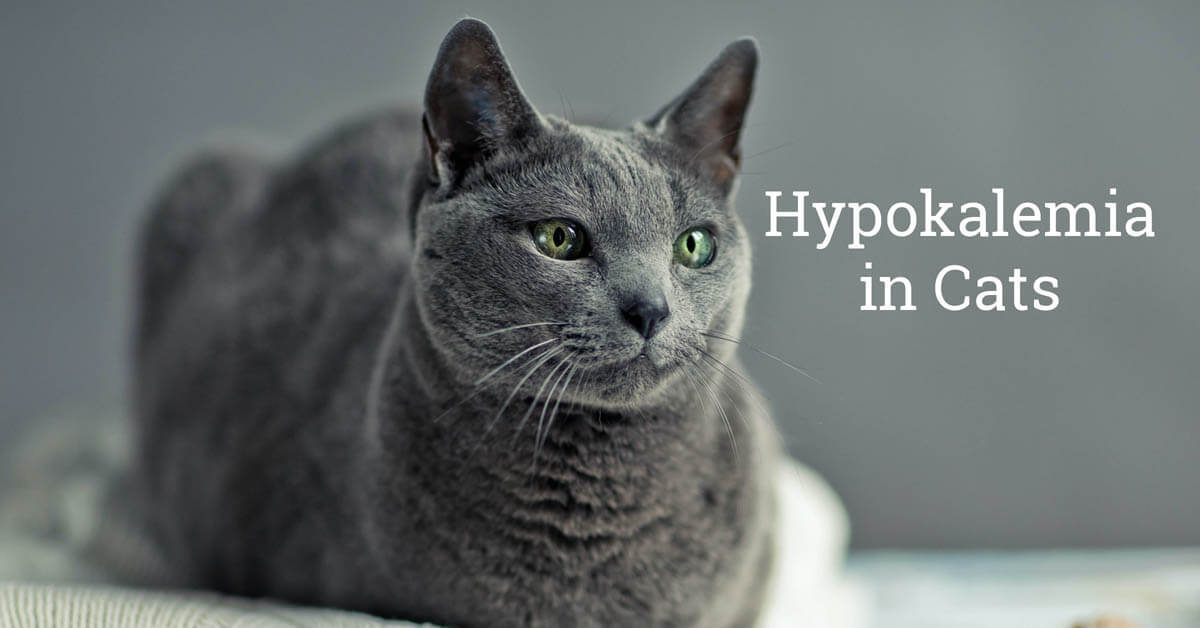What is hypokalemia?
Hypokalemia is a deficiency of potassium in the blood plasma, the straw-coloured, liquid part of the blood which makes up approximately 55% of the blood volume. Also known as kalium (with the symbol K), cats obtain potassium through their diet. Over 90% of potassium is located within the body’s cells (intracellular), the remainder is present in the extracellular fluid of the blood. Kidneys control levels of potassium by excreting excess out of the body via the urine.
| Normal | Low (hypokalemia) | High (hyperkalemia) |
| 4 – 4.5 mmol/L | <3.5 mmol/L | > 5.5 mmol/L |
What is potassium?
Potassium is an essential electrolyte that performs several functions including
- Helps maintain blood pressure.
- Maintains the body’s electrolyte balance and acid/alkali levels in cells and tissues.
- It plays an important role in heart, skeletal, and smooth muscle contraction (including the heart). Transmitting messages from the nerves to the muscles, making it important for normal heart, digestive, and muscular function.
- Transports nutrients into cells and removes wastes from cells.
- Maintains intracellular volume.
Causes
- Increased loss of potassium
- Decreased intake of potassium
- Translocation (movement) of potassium from the extracellular fluid into the intracellular fluid
By far, the most common cause of hypokalemia in cats is a loss of potassium due to increased potassium excretion in cats with chronic kidney disease (CKD). Vomiting is common in cats with CKD which exacerbates the problem.
Increased loss or decreased intake of potassium:
- Decreased potassium intake: Diet low in potassium, insufficient amounts of food, loss of appetite, or inadequate diet.
- Gastrointestinal loss: Prolonged vomiting and/or diarrhea.
- Urinary loss of potassium: Chronic kidney disease, diabetes and certain medications such as furosemide.
- Diabetes: Decreased appetite and increased urination.
- Hyperthyroidism: Has been linked to hypokalemia, but the exact mechanism isn’t known.
- Post obstructive diuresis: Once the urinary obstruction is removed, urine output will increase. The kidneys are able to resume their job of urine production to remove toxins from the bloodstream.
- Primary or secondary hyperaldosteronism (also known as Conn syndrome): The adrenal glands sit on top of the kidneys producing a number of hormones. The outer layer (known as the cortex) produces two hormones, cortisol, and aldosterone. The latter hormone, aldosterone is responsible for elevating blood pressure when necessary, during this process, potassium is excreted from the body via the urine. These hormones are usually kept in check, however, when aldosterone levels rise abnormally, excessive amounts of potassium can be lost. Primary hyperaldosteronism is caused by a hormone-secreting tumour of the adrenal gland(s), the secondary can be due to kidney disease, congestive heart failure or liver disease.
- Inherited hypokalemia (familial episodic hypokalemic polymyopathy): This has been known to affect some Burmese and related cat breeds.
Potassium shifts from the extracellular to the intracellular fluid:
- Administration of sodium bicarbonate: Can push potassium into cells.
- Administration of insulin: Drives potassium into cells.
- Glucose administration: Stimulates insulin production, which drives potassium into cells.
Symptoms
Mild cases of hypokalemia are usually asymptomatic and in most cases, clinical signs relate to the underlying cause and not hypokalemia itself.
Cats with moderate to severe hypokalemia will present with symptoms due to low potassium which interferes with the contractibility of skeletal, cardiac and smooth muscles. One of the first symptoms of hypokalemia in cats is severe muscle weakness which is due to the higher loss of potassium from the muscles compared to other tissues. Abnormal heart rhythms (arrhythmias) can develop in the heart (also a muscle).
- Lethargy (decrease in activity)
- Weakness
- Muscle pain (myalgia)
- Stiffened posture and gait
- Reluctance to move
- Ventral neck flexion (inability to raise the head due to muscle weakness)
- Increased thirst and urination (due to decreased kidney function)
- Weight loss
- Muscle wasting
- Dull coat
Severe cases can cause death either due to abnormal heart function or paralysis of the respiratory muscles.
Depending on the underlying cause, other symptoms may also be present such as those associated with kidney disease.
Diagnosis
The veterinarian will perform a complete physical examination of your cat and obtain a medical history from you, which will include any medical conditions your cat may have and medications he may be taking, duration and type of symptoms your cat has displayed. During the examination, he will detect bradycardia (abnormally slow heartbeat).
Diagnostic workup:
- Biochemical profile: Potassium is decreased. Elevated BUN (blood urea nitrogen) and creatinine levels in cats with kidney failure.
- Urinalysis: A test of a sample of the cat’s urine to measure levels of potassium.
- Urine specific gravity: To determine how concentrated the urine is as well as evaluate for excess potassium.
- Complete blood count: May reveal mild anemia if your cat has chronic kidney disease.
- Electrocardiogram: A non-invasive test that uses high-frequency sound waves to capture live images of the heart to determine if hypokalemia has affected normal heart function.
- Genetic testing for Burmese and related breeds suspected having familial episodic hypokalaemic polymyopathy.
- Additional diagnostic tests may also be necessary to find the underlying cause. This may include ultrasound or x-rays to evaluate the kidneys and T3 and T4 tests to check for hyperthyroidism.
Treatment
The goal of treatment is to return serum potassium levels to normal by reducing potassium losses, replacing lost potassium, closely monitoring potassium levels and treating the underlying cause. Medications to control diarrhea and/or vomiting, intravenous administration of concentrated potassium for severely affected cats until stabilised, then switch to oral potassium. This therapy does not come without its risks, however, and it is important to monitor potassium levels.
Prognosis
Most cats who receive treatment will make a full recovery and an improvement can be expected 1-3 days after administration of potassium.
Cats with chronic kidney disease will need ongoing treatment to manage the disease. While there is no cure for chronic kidney disease, it is possible to slow down its progression.

